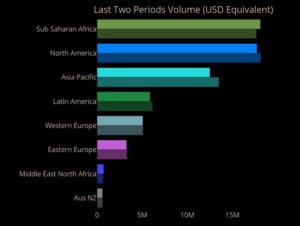In an earlier post, Terry Saunders, IBM Utilities Industry Leader, talked about how energy and utility (E&U) companies are part of the critical infrastructure that makes up our lives. In this post, he discusses E&U in a post-COVID world, what he sees coming next, and offers utility professionals some great advice on digital transformation.
Below is part two of this two-part series with our questions and his answers.
Q: What is exciting to you in the coming years and what excites your customers?
Utilities are at a major inflection of change that they have never seen historically. We’ve all been encouraged to be more efficient – think LED lighting, high efficiency HVAC and appliances, roof top solar and electric vehicle (EVs). We can adapt to different shower heads, toilets and irrigation, as well as drought resistant landscaping that uses considerably less water – so utilities have been educating their customers while delivering technologies that reduce consumption of utilities. There is a push to sustainability and zero carbon — don’t waste gas, or water, or electricity; look to decarbonization and electrification. That affects our homes, our businesses, and our lives in support of sustainability and resilience.

Terry Saunders, Worldwide Utilities Industry Leader for IBM Cloud and Cognitive Software
But there is a certain cost to infrastructure regardless of what is used – and many utilities’ revenue has gone flat or declining with aging infrastructure. We may experience more outages due to aging infrastructure and extreme weather events. In addition, utilities have experienced a disruption of their traditional business model. There is significant private encroachment in the electricity market – Google, Apple, Amazon, and many others are putting up their own wind and solar farms and selling the excess electricity generated. Now, utilities must make up the revenue to support the business.
Electrification: a new direction and a major shift
The direction is going to be electrification – because that can be supplied by renewables such as wind, solar and hydro. That’s a major change of investment for the utilities. Currently, there are not enough people who are skilled in the ways utilities will need. And there’s where the need comes to embrace AI and AR, machine learning, cognitive and visual inspections. This is where we’re going to use AR with an expert from a central location in an industrial facetime session and then use AI to assist and guide in making the repair.
“The most exciting time to work in the industry.”
To me, it’s the most exciting time to work in this industry. Without reliable and safe utilities economies can’t grow. We’re going to see tremendous efficiency gains from things such as electricity generated closer to consumption so that we do not experience the loses through electric transmission. Carbon affects our weather and even if we got to zero carbon today, we’d still have extreme weather events. That’s why we need technology from the IBM Environmental Intelligence Suite, for instance, so that we can forecast weather events such as thunderstorms, windstorms, firestorms, hail, blizzards and super storms. Accurate, very localized weather predictions will also be used to optimize solar and wind generation.
IBM plays a big role in helping utilities understand assets and business demands. There’s so much that can be done so that we don’t have to continue to depend on carbon-producing power plants. If we’re able to manage and control usage we can begin to levelize demand and eventually satisfy peaks with large scale battery storage.

According to Bloomberg New Energy Finance by 2040, 58% of global passenger vehicle sales will come from electric vehicles.
Even though my car gets 58 miles per gallon, I know I’ve bought my last diesel vehicle. The next car will be electric. We need to get people into electric cars and electric forms of transport. In the future, when you plug those in, they can also supply the grid, using the vehicles storage to offset the demand. I often don’t say batteries but rather electrical storage. Because it might not be batteries, or at least batteries as we know them today. The holy grail to the entire electric grid is storage – the sun shines during the day, the wind blows also at night – and we need to use or capture and store all that energy during lower demand.
Q: What is the best piece of advice you would give to an energy and utility customer looking at digital transformation?
Try to consolidate systems and remove redundancies. Don’t be short-sighted on your employees’ ability to absorb and adapt to change. Don’t be afraid to have them talk to machines; we’re getting used to talking to Alexa and Siri. For example, my son talks seamlessly to his phone when he texts, he doesn’t type. We underestimate people’s ability to adapt to change.
Also, start to look at ways to adopt new technology. All we have to do is look at how cell phones changed over the last 30 years. Your smart phone is now a very powerful computer. We now can ask questions into a web browser, Google, Firefox, Safari or an AI like Alexa, Siri or Watson. Embrace and engage the technology. The sooner you embrace it, you can adapt your business, and accelerate your ability to compete.
Instead of a proof of concept, I like to encourage people to focus on proof of value. Start with a specific business use case and prove the value. Then try another and another and another like bricks building a strong wall for the future. Embrace the change, expose your people to the change. Be a role model, be innovative, be a leader to a better future.
More resources for energy and utility professionals
Source: https://www.ibm.com/blogs/internet-of-things/energy-and-utility-conversation-part-2/
- "
- advice
- AI
- Alexa
- All
- Amazon
- Apple
- AR
- Assets
- batteries
- battery
- battery storage
- BEST
- Bloomberg
- browser
- Building
- business
- business model
- businesses
- car
- carbon
- cars
- cell phones
- change
- charged
- closer
- Cloud
- cognitive
- coming
- Companies
- consumption
- continue
- Conversation
- Critical Infrastructure
- Customers
- day
- delivering
- Demand
- diesel
- digital
- Digital Transformation
- Disruption
- efficiency
- Electric
- electric car
- electric vehicle
- electric vehicles
- electricity
- energy
- environmental
- events
- FaceTime
- Farms
- finance
- Firefox
- Focus
- future
- GAS
- Global
- Grail
- great
- Grid
- Grow
- guide
- High
- How
- HTTPS
- hvac
- IBM
- IBM Cloud
- industrial
- industry
- industry Leader
- Infrastructure
- Intelligence
- investment
- IT
- large
- learning
- Led
- location
- machine learning
- Machines
- major
- Making
- Market
- model
- Offers
- offset
- Others
- People
- phones
- plants
- Plugged
- power
- Predictions
- private
- professionals
- proof
- proof of concept
- reduce
- Renewables
- Resources
- revenue
- Safari
- safe
- sales
- Scale
- sees
- Series
- siri
- smart
- So
- solar
- son
- start
- storage
- store
- supply
- support
- Systems
- talking
- Talks
- Technologies
- Technology
- The Future
- time
- top
- Transformation
- transport
- utilities
- utility
- value
- vehicle
- Vehicles
- Water
- Watson
- web
- web browser
- What is
- WHO
- wind
- Work
- world
- worldwide
- years
- zero





